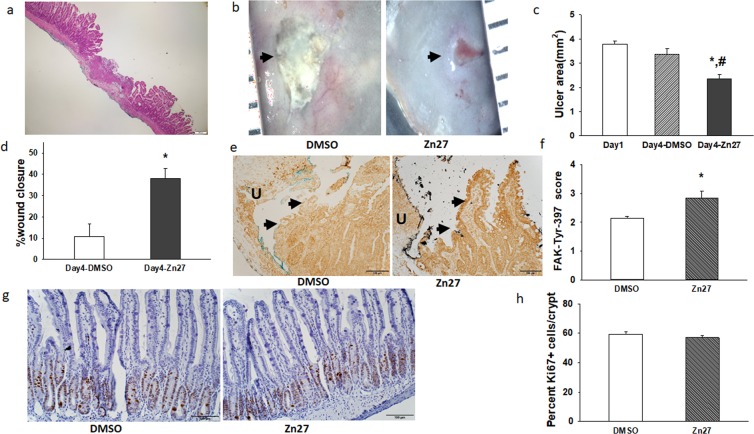Figure 5.
ZINC40099027 promotes intestinal mucosal healing in a murine ischemic ulcer model. (a) Hematoxylin and eosin staining of an ischemic ulcer at day 4. (b) representative images of jejunal ischemic ulcers in DMSO-treated mice and ZINC40099027-treated mice at day 4. (c) Ulcer area in mice receiving DMSO or ZINC40099027 at day 4 is compared to ulcer area in a group of mice sacrificed at day 1 before treatment with DMSO or ZINC40099027. ZINC40099027 substantially reduces ulcer area after 3 days of intraperitoneal injection every 6 hours. (n = 12, *p < 0.05 vs day1, # p < 0.05 vs DMSO). (d) Percentage of mucosal wound healing at day 4 in mice treated with DMSO or ZINC40099027 compared to the ulcer size at day 1 emphasizes the acceleration of ulcer healing by ZINC40099027. (n = 12, *p < 0.05). (e) Representative immunohistochemical images of FAK-397 phosphorylation in epithelium at the edge of the ulcer bed from DMSO control or ZINC40099027-treated mice. Arrows indicate epithelium at the edge of the ulcer. Dark brown staining indicates FAK-397 immunoreactivity. Green and black ink was used for coding sections. (f) Blinded immunoreactivity scores are increased in ZINC40099027-treated ulcers vs. DMSO-treated ulcers (n = 5, *p < 0.05). (g) Representative hematoxylin –counterstained immunohistochemical images of Ki67-stained crypts from DMSO or ZINC40099027-treated mice. Dark brown staining indicates Ki-67 immunoreactivity. (h) The percentage of Ki67-positive cells per small intestinal crypt did not differ between in DMSO or ZINC40099027-dosed mice.

